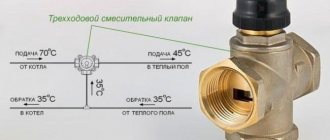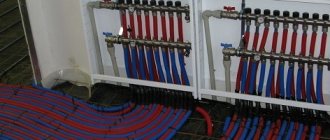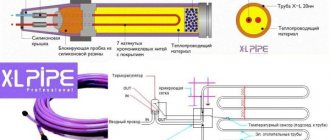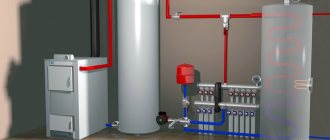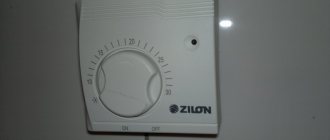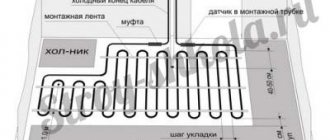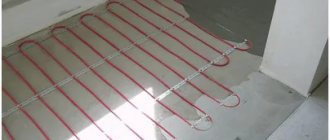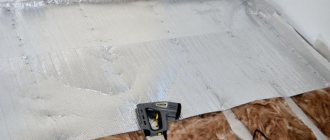In our country, underfloor heating systems appeared relatively recently, and for a long time remained a non-standard heating method and one of the signs of wealth. Today they have become widespread in the field of private country house construction, both in combined heating systems and as an alternative to radiators. In both cases, water heated floors are most in demand; with the help of an Uponor specialist and members of our portal, we will understand the basis for the ever-increasing demand for these systems and how to automate them.
This article is part of the FORUMHOUSE Academy course.
Why are heated floors so popular?
The main difference between water heated floor systems and radiator systems is not so much the hidden installation of the coolant circuit, although this is the basis for many advantages, but rather the lower temperature of the coolant. In European countries, these systems have successfully stood the test of time - for more than half a century, even in the northern part of the continent, they have been used as the main source of heat. Naturally, such a choice is determined solely by practicality, and not by mentality.
Maria SukharevaSpecialist at Uponor
Due to the characteristics of floor systems, we can say that they are economical, environmentally friendly and aesthetically pleasing. Low-temperature surface heating systems produce soft radiant heat and act directly on a person, without intermediate heating of the air masses in the room. This allows you to reduce the temperature in the rooms, while maintaining the required level of comfort and reducing heating costs.
And we are talking not only about comfort, but also about the preferred microclimate.
Oleg NosykForumHouse Member
The heat emitted by a heated floor is perceived many times better than convection. This is due to the biological structure of our body. According to the results of scientific research, a person experiences a feeling of comfort and warmth when the temperature at the level of his feet is slightly higher than the temperature at the level of his head. The optimal condition is when the floor surface temperature is from 20 to 29°C, and at head level – from 19 to 24°C.
In addition to the fact that “a healthy mind is in a healthy body,” underfloor heating is also beneficial.
- From a cost point of view - although a heated floor is more expensive at the installation stage, it is more profitable during operation, due to less heating of the coolant and uniform heat distribution, energy savings vary between 12-15%.
- From a decorative point of view, only exclusive designer radiators can become an interior decoration; available standard models, at best, will not spoil the view. But even then they will create certain restrictions when decorating the interior, while a hidden heating system, on the contrary, “frees your hands.”
- From a practicality point of view, a convective heating system based on the circulation of air masses is also accompanied by the circulation of dust settling on all surfaces. And this is not only unnecessary cleaning, especially if the interior is in dark colors (not to mention the radiators themselves and the space behind them), but also an unfavorable factor for asthmatics and allergy sufferers.
Underfloor heating is chosen both to preserve aesthetics, especially when the glazing is panoramic, and to keep “your feet warm and your head cold,” and in the hope of staying in the black over the years. The effectiveness of water heated floors has been proven by practice - the bulk of built or reconstructed country houses today are heated primarily by a combined system, heated floors and radiators, or only heated floors. Moreover, multi-storey buildings in residential complexes began to be equipped with similar systems as the only source of heat.
Maria SukharevaSpecialist at Uponor
To increase the level of comfort of residents, create an optimal microclimate and reduce heating costs, a water heated floor system was chosen for one of the residential complexes in St. Petersburg. On average, this reduced energy consumption in apartments by 20%.
System parameters:
- The pipes used are cross-linked polyethylene PE-Xa 17×2.0 (with an anti-diffusion layer).
- Laying - spiral (to ensure uniform heat transfer).
- The pitch of laying loops is 200 mm and 100 mm (above windows and end walls).
For maximum efficiency, the systems are equipped with automatic control systems.
The bulk of the problems attributed to water heated floors (zebra crossing, hot/cold, leaks, etc.) are not related to shortcomings of the system as such, but to design errors, low-quality components or violations of installation technology.
Adjusting water heated floors
How to fill a heated water floor
If we consider how to regulate a water-type heated floor, we can immediately note the complexity of the techniques used, in comparison with electric heating. In particular:
- a method of smoothly adjusting the water temperature in the system is used, since sudden surges lead to airing;
- there are several schemes for mixing hot coolant into the heating circuit;
- it is assumed that a separate circulation system will be installed for each control zone of the apartment or house;
- There is an option to use semi-automatic means of maintaining the temperature of the coolant simultaneously with thermostats.
Let's look at several control schemes for water-heated floors, starting from the simplest.
- Changing the coolant flow mechanically. This adjustment system is (from the user's side) a simple faucet. By opening it or incompletely closing it, the overall heat transfer is changed. In fact, the mechanical control system is more complex than a faucet, but the control principle is similar to its operation. The above diagram is of little use if the house has one main circulation pump. The mechanical system will affect the heating efficiency of all rooms.
- Supercharger control. By turning the circulation pump on and off, the required parameters of the coolant in the pipes are maintained. Switching can occur both according to the signal from the thermostats and in accordance with the parameters of the sensor installed in the heating circuit. In order to achieve separate microclimate regulation in a single room, you will have to equip your own water passage structures in each of them, equipped with blowers. If this is not done, the main circulation pump at some points in time can turn off the heating in the entire house.
- The thermal head can act as an effective semi-automatic means of temperature control. It is more inconvenient compared to a wall-mounted thermostat; it works on the following principle: it opens the supply of heated water if the temperature in the control circuit drops and, vice versa, it shuts it off when the set limit is reached. The thermal head controls the three-way valve.
The listed techniques refer to the so-called single-point control schemes. They regulate the operation of a separate circulation path or zone of the heating system. More advanced methods include servo-driven distributors. Depending on the indicators of the sensors, such devices can redistribute the flow of heated water into separate controlled zones.
Is there enough underfloor heating to heat the house?
Just as it is clean not where they sweep more often, but where they don’t litter, so it is warm not where they heat more, but where there is less heat loss. In order for the temperature in the house to be comfortable for residents, the heat supply must cover its outflow through the building envelope. In houses of the previous generation, this was achieved mainly by increasing power and simply “burning” the stoves or boilers more strongly. Now, with such a system, you can literally “go down the drain” on your energy bills, and all efforts are devoted to reducing the outflow. And in houses with a sealed circuit, the type of heating system practically does not matter, since due to insulation, heat loss is minimal and heating only with the floor can be sufficient to replenish it. However, in each specific case, an accurate thermal calculation is required, taking into account the individual parameters of the house.
GarryRUFORUMHOUSE Member
Maintaining a comfortable temperature in the house is the task of a properly designed heating system. If, according to thermal calculations, it turns out that a warm floor, with a normalized surface temperature, is enough to achieve a comfortable temperature, then nothing else is needed. If not, then you need to add other heating devices.
According to building and sanitary standards, on average, 100 W of heat is needed to heat 1 m² of space, and it is quite possible to remove such an amount from a heated floor. But it all depends on the insulation.
vovovaFORUMHOUSE Member
If we take 29°C as the maximum floor surface temperature for residential premises (according to SNIP), then at a temperature of 24°C and tiles on the floor you can get 65 W/m². For a poorly insulated house, this will not be enough during the coldest period. Solution: either violate SNIP and increase the surface temperature, or additional heating during periods of severe frost, or lower the temperature in the premises to 20°C. But this is for poor insulation. Heat loss at home must be calculated carefully in order to know what you can count on during the cold period.
With good insulation, you can count on a much more encouraging figure.
OsyaForumHouse Member
I, too, when I started building, thought that I would need at least 18 kW for 180 m². The conclusion after calculating the heat loss of the house is that 10 kW is enough, since the heat loss was a little more than 50 W/m².
There are also examples of how uninsulated houses are successfully heated with warm floors.
omegasFORUMHOUSE Member
The house is made of timber (180 mm), heated area is 80 m², I have been heating it since September. An interesting week passed (late January), when the frosts were firmly over 30, and sometimes over 40⁰C. The water heated floor proved to be amazing; the microclimate at home is unchanged, which even somewhat contradicts the calculated one. So, with the help of VTP, it’s quite possible to heat even an uninsulated house in Siberia, but I’ll try to thoroughly insulate it by next winter. True, I had to increase the flow a little, the floor is now 30-31 C⁰, my feet feel normally warm, I don’t even want to lower the temperature, it’s so nice to walk on it.
Omegas considers insulation a necessity, since exceeding the standard maximum of 29⁰C is still not the best option, even periodically, and energy costs in an insulated house are much lower. After the insulation was completed the next season, not 3.5, but 2 tons of diesel fuel were needed for heating, although the winter was colder.
Temperature control devices
One of the simplest floor heating control systems are servo drives installed on the manifold control valves. The device operates on the principle of a switch - when the maximum temperature is reached, the movement of the coolant through the serviced circuit completely stops, and after cooling the area it resumes again. Such performance equipment is ideal for installation in every room. Servo drives are produced in two modifications - with a normally open and normally closed drive.
An equally simple way to regulate the heating of the coolant is a circulation pump that turns on and off depending on the temperature. The principle of operation of the device consists of a sensor mounted between the pipes. Another type of automation for servicing heated floors is a thermal head, supplemented by a temperature sensor installed in a certain area of the system, the temperature of which will be controlled during operation of the heating network.
Regulating the temperature of the heated floor
A more complex version of automation for water heated floors are thermostats equipped with switching control modules, which increases the reliability of the entire structure, including the boiler and pump. One such device is designed to service several servos, that is, it is capable of providing full heating of a fairly large room. Products come in open and closed types. The first ones are mounted directly on the wall, the second ones - in a special mounting box.
Important: It is possible to regulate the heating of the coolant taking into account the outside air temperature only when using a special device - a heated floor controller, otherwise called a climate compensator. .
